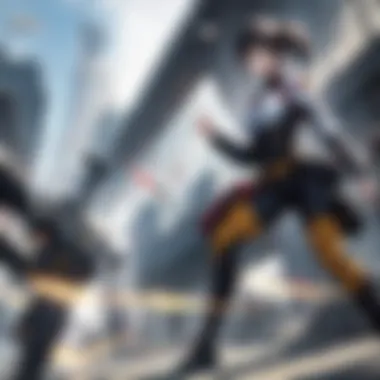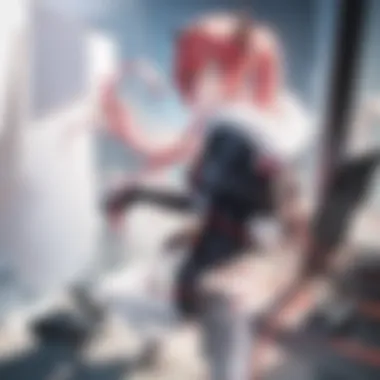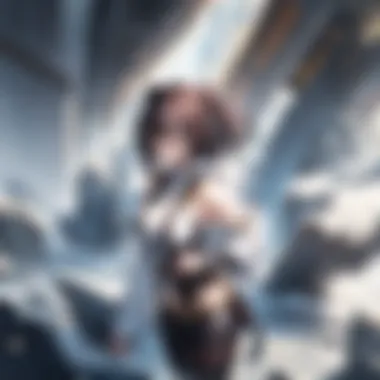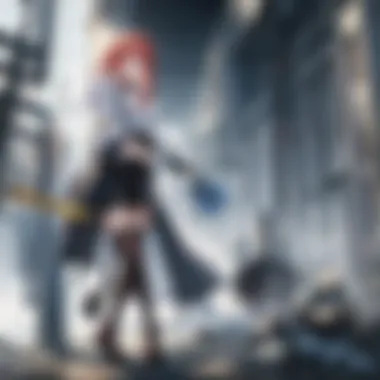Understanding Manga FX: Techniques and Applications


Intro
Manga FX encompasses a range of techniques that elevate the storytelling in manga and anime. These effects serve not only to beautify art but also to convey deeper narratives and emotions. Intricate designs and artistic effects can amplify the viewer's experience, creating a visceral connection with the story. With a growing audience around the world, understanding how Manga FX operates is vital for both creators and fans alike.
Series Overview
Synopsis and Premise
Manga often explores complex narratives within compact panels. Manga FX plays an essential role, providing clarity and emphasizing action. Effects can include speed lines, dramatic shading, and environmental impacts, each contributing uniquely to the overall storytelling. The integration of these elements can determine how a scene is perceived and understood by the audience.
Notable Characters
Manga stories feature a variety of characters, each distinct in their portrayal. The use of Manga FX elevates their personalities. For instance, the explosion of effects during a character's fierce moment can signal their emotional journey. Likewise, subtle effects may underline internal conflict. Such dynamic representation engages readers, making them invested in outcomes.
Themes and Motifs
Major Themes Explored
Numerous themes run through manga stories, from friendship to the quest for identity. Manga FX can underscore these stories, articulating silent themes like despair or triumph without explicit dialogue. Effects visually narrate underlying sentiments, proving that sometimes a picture can convey what words cannot.
Symbolism in Storytelling
Symbolism manifests in numerous ways through Manga FX. A shattered shard could represent a character’s broken spirit, while blooming blossoms might suggest hope or renewal. Such subtlety enhances comprehension of complex narratives, allowing the audience to engage interactively.
Artistic Style and Animation
Visual Aesthetics and Design
The aesthetic appeal of manga is often reinforced by Manga FX. Styles can range from minimalist effects to intricate visual motifs. The aesthetic design influences how the audience perceives a story's tone. Whether it's the fluid lines of a romantic scene or the jagged edges of a horror moment, the visual choices amplify emotional feedback.
Animation Techniques and Trends
Incorporating Manga FX has also begun to influence anime adaptations. Techniques once limited to printed media are now finding their place in animation. Innovations such as CGI and 3D modeling factor heavily into how Manga FX is presented, with animators striving to replicate the original feel of manga. As trends evolve, so does the potential for new methods of storytelling that engage audiences differently.
Manga FX is not just about styles; it's about enhancing the narrative experience.
The synthesis of these elements illustrates the diverse applications of Manga FX in contemporary visual storytelling, catering effectively to the evolving preferences of manga and anime enthusiasts.
Prologue to Manga FX
Manga FX plays a crucial role in the realm of visual storytelling, particularly in manga and anime. These effects serve not only to enhance the aesthetic appeal but also to deepen emotional engagement and narrative structure. Understanding Manga FX encompasses recognizing the various techniques used to convey mood, action, and atmosphere throughout a story. The relevance of this topic lies in its ability to connect visual art with storytelling, enabling readers to immerse themselves in the characters’ journeys.
Through this article, we will explore essential elements of Manga FX, including its techniques and applications. This examination reveals how these effects contribute to character development and reader engagement, making them integral to the storytelling process. Considerations about Manga FX include how these devices can either elevate or detract from a narrative, depending on their implementation.
Defining Manga FX
Manga FX encompasses specialized techniques that create visual effects enhancing the storytelling in manga. These include speed lines, impact effects, and sound effects, among other forms. These effects help to emphasize emotions and illustrate actions dynamically. The integration of these techniques enriches the narrative and helps the reader to interpret the intended feelings and movements of characters.
In recent years, the use of Manga FX has expanded significantly with technological advancements. Digital platforms allow for more complex effects that were previously limited in traditional forms of manga. As a result, understanding Manga FX is essential not only for artists but also for writers and readers who appreciate the depth these tools add to the narrative.


Historical Context of Manga Effects
The history of Manga FX is rooted in the evolution of visual storytelling itself. From early printed works to contemporary digital formats, these effects have transformed. Initially, simple illustrations conveyed action and emotion. Over time, more sophisticated techniques emerged, allowing artists to create intricate dynamics within their artwork.
In post-war Japan, manga became a prevalent medium. Artists began exploring various ways to depict motion and sound, leading to the establishment of enduring styles that define Manga FX. As manga and anime gained international popularity, elements of stylistic effects influenced global comics. This cross-cultural exchange allowed for innovative techniques that merge traditional manga aesthetics with contemporary influences, shaping the future of visual storytelling.
Understanding the historical context provides valuable insight into why certain Manga FX techniques are applied today. It illustrates their evolution and significance in today's manga culture.
The Role of Effects in Storytelling
Manga FX plays a pivotal role in the art of storytelling within the medium. These visual techniques are not merely decorative; they serve as essential tools that deepen the narrative. By employing various effects, creators can elevate the reader's experience, guiding their emotional journey through the story. This section discusses how these effects contribute to character development, enhance thematic elements, and maintain reader engagement.
Emphasizing Emotion and Action
Manga FX has a unique ability to convey emotions vividly. Effects such as speed lines illustrate the urgency or intensity of a scene. For instance, when a character is about to engage in a dramatic action, the addition of these lines can signal impending movement, creating anticipation. \n Moreover, emotional states can be visually represented through effects like sweat droplets, hearts, or even distorted backgrounds. These visuals provide instant context, enhancing the audience’s understanding without relying entirely on dialogue. Using the appropriate effects can make a character's joy or sorrow instantly recognizable, thus reinforcing their emotional arc within the plot.
Additionally, onomatopoeic expressions like "BANG!" or "THUD!" added alongside action scenes further amplify the sensation of impact. This method not only heightens the sensory experience for the reader but also ensures that the emotional gravity of the moment resonates more profoundly.
Creating Atmosphere and Setting
The creation of atmosphere in manga is intricately tied to the effects employed. Background textures, shading techniques, and environmental effects can subtly establish the mood. For example, a setting illuminated by harsh shadows can induce a feeling of suspense. Conversely, soft pastels in a serene scene communicate tranquility, enriching the narrative.
Furthermore, incorporating visual elements like rain, wind, or even abstract shapes can signal weather changes or emotional shifts within the storyline. Such effects function as symbols that signal transformations in the narrative. They can also help the audience connect with characters on a more intimate level, as settings often reflect inner conflicts or themes.
In summary, the role of effects in storytelling is multifaceted and crucial. They employ visual techniques that foster rich emotional experiences and provide contextual depth, making narratives more engaging and resonant.
Types of Manga FX
Manga FX encompass a wide range of techniques that enhance visual storytelling. Understanding the various types of effects is essential. They play a crucial role in conveying emotions, actions, and the overall atmosphere of a scene. By breaking down these elements, readers can appreciate the artistry behind manga and how it shapes the narrative. Each type serves specific functions and caters to different genres, making their mastery vital for creators.
Speed Lines and Motion Effects
Speed lines are a fundamental part of manga, often used to depict fast movement and action. They create a sense of urgency, directing the reader’s eye and escalating the tension within a scene. For example, during a high-stakes chase, the use of speed lines can visually convey how quickly characters are moving. This not only enhances the excitement but also mimics cinematic techniques that capture rapid movement.
Motion effects can include various styles, from blurred backgrounds to exaggerated distortions of the characters themselves. The effective use of motion FX can dramatically enhance the impact of fight scenes and dramatic confrontations, making them feel more visceral. As a creator, understanding how to balance these lines without overwhelming the artwork is essential. In effective use, speed lines do not distract but rather support the main narrative and artistic goals.
Sound Effects in Manga
Sound effects, often represented by onomatopoeia, are more than just supplementary elements in manga. They contribute significantly to the storytelling. The typography and style used for sound effects can communicate the intensity or nature of an action. For example, a bold and jagged font may suggest a powerful punch, while a smooth and flowing font might represent gentle rain.
These effects engage the reader’s imagination and enhance their immersion. Moreover, they can influence pacing, as a quick sound effect can quicken the reading speed, while a prolonged one encourages reflection. By considering the design of sound effects, creators add layers of meaning that go beyond the visual elements of the panels.
Impact Effects and Onomatopoeia
Impact effects create a visual representation of physical interactions. When characters collide or objects shatter, these effects emphasize the consequences of actions. Using impact effects, artists can visualize the force behind an event. Onomatopoeia is thus an integral part, often written alongside these visuals.
For example, the sound “BAM!” can accompany a punch or crash. The combination of visual impact and sound reinforces the dramatic nature of the scene, enhancing reader engagement. Furthermore, placement matters; placing these effects strategically within the panel guides the reader’s focus and heightens the overall experience.
Background and Foreground Effects
The distinction between background and foreground effects is a key aspect of manga art. Foreground effects can highlight actions, while background effects help establish the setting. For instance, a blurred background during an intense action scene can draw attention to the characters in motion, minimizing distractions.


On the opposite end, detailed background effects provide context and depth to a scene. These can include environmental elements like weather, buildings, or celestial objects, which contribute to world-building. The interplay between these layers can shape the mood and tone of the manga.
Popular Manga FX Techniques
Manga FX techniques play a crucial role in visual storytelling. They not only enhance the narrative but also provide depth to characters and settings. As manga evolves, understanding these techniques becomes essential for creators and readers alike. The importance of recognizing and mastering these methods cannot be overstated, particularly as they have a direct impact on how stories resonate with the audience.
Screen Tones and Gray Shading
Screen tones are a fundamental aspect of manga FX. They provide texture and depth to images, allowing artists to convey emotions, moods, or atmospheres effectively. Traditionally, artists used physical sheets of screen tone, which required careful application to ensure consistency. Today, digital tools have transformed this process, making it simpler yet equally effective.
The use of gray shading within this context serves to enhance visual clarity. Different shades can symbolize various emotions or states of mind, effectively guiding the reader's perception. Artists employ these techniques to create contrast and emphasize significant elements in a scene, thus aiding in storytelling. When utilized correctly, screen tones can significantly uplift a character’s representation, strengthening the overall narrative impact.
Digital Tools Revolutionizing FX
With the rise of technology, digital tools have revolutionized the creation of Manga FX. Programs like Clip Studio Paint, Adobe Photoshop, and Procreate allow artists to create intricate effects with ease. These applications offer a wide range of brushes, textures, and tools specifically designed for manga creation. As a result, artists can experiment with various effects that were previously labor-intensive or challenging.
The flexibility offered by digital platforms facilitates faster production timelines while maintaining high-quality visuals. The ability to undo, modify, and adjust elements easily allows for a more dynamic creative process. This transition has not only expanded artists’ techniques but has also shaped audience expectations, as they now encounter a broader array of visual styles in contemporary manga.
Cinematic Techniques in Manga Effects
Cinematic techniques have increasingly shaped the development of Manga FX. Techniques such as framing, perspective shifts, and dynamic angles draw readers into the story effectively, reminiscent of film editing. These methods create a sense of motion and fluidity, making readers feel part of the action.
Imitating movements and focusing on different perspectives showcases the artistic mastery and storytelling capabilities of the creator. This substantial integration of cinematic elements deepens the reader's engagement. For example, an action sequence may utilize a variety of angles to amplify tension and excitement, while a quiet, dramatic moment might employ a slow zoom or change in focus to enhance emotional impact. As manga continues to evolve, the combination of these techniques will likely propel its narratives even further into innovative territories.
"The integration of cinematic techniques into manga FX creates a richer storytelling experience, merging two powerful forms of visual art into a cohesive narrative flow."
Understanding these popular Manga FX techniques opens new avenues for both artists and readers, enriching the overall experience of manga. These elements not only shape the visual landscape but also enhance character portrayal and thematic development.
The Cultural Impact of Manga FX
Manga FX has a significant role not only in visual storytelling but also in the broader cultural landscape of both Japan and the world. These effects are not merely decorative; they enhance storytelling, helping to convey emotions and situations in ways that words alone can’t express. The impact of Manga FX transcends the page, influencing various media forms and contributing to the evolution of artistic expression across genres.
Influence on Anime Adaptations
The relationship between manga and anime is intrinsical. Many animated series draw directly from manga, and the visual effects found in manga are often translated into their anime adaptations. This transition illuminates how dynamic storytelling can be when enhanced with effects. For example, series like Naruto and Attack on Titan utilize speed lines and motion blur to convey intense battle scenes, capturing the frenetic energy present in the original manga.
Additionally, anime adaptations often retain or embellish the effects seen in manga to draw in viewers. The subtle shifts in emotional tone can be conveyed through the careful application of effects like exaggerated expressions and atmospheric backgrounds, hallmarks of Manga FX. This form of storytelling aligns with the expectations of audiences familiar with manga, making the anime more appealing and engaging.
Manga FX in Global Comics
The influence of Manga FX extends beyond Japan, impacting comic artistry across the globe. Western comics have begun to incorporate various techniques inspired by manga. The use of effects, such as dynamic panel layouts and innovative visual styles, can be seen in works like Scott Pilgrim by Bryan Lee O'Malley, where motion lines and exaggerated actions visually convey energy.
Important Aspects of Manga FX in Global Context:
- Cross-cultural Adaptation: Artists from various backgrounds have adopted Manga FX techniques to create culturally blended forms of storytelling.
- Visual Storytelling Dynamics: The integration of Manga FX allows for a more immersive reading experience.
- Enhanced Engagement: By using effects similar to those found in manga, global comics can draw in new audiences who may be more familiar with the stylistic elements of manga.
Accordingly, Manga FX is more than a stylistic choice. It shapes how stories are told and perceived, influencing a new generation of artists worldwide. As productions continue to explore diverse narratives, the techniques derived from Manga FX contribute to a richer exchange of ideas and aesthetics across cultures.
Case Studies of Effective Manga FX Use
Case studies in Manga FX play a crucial role in understanding how specific effects can enhance storytelling. This section serves to underscore the significance of using Manga FX not just as decor but as integral components that shape the narrative. Each case study delves into popular series, illustrating how effects are carefully employed to heighten emotional resonance and immerse readers in the story.


Analysis of Popular Series
Examining series such as Naruto and Attack on Titan reveals notable applications of Manga FX. In Naruto, the use of speed lines during combat sequences amplifies action, allowing the reader to experience the intensity of battle. These lines are often accompanied by dynamic sound effects that create a cacophony of auditory imagery, which serves to heighten the overall impact of the confrontation.
In contrast, Attack on Titan utilizes shadow effects to create tension and atmosphere. The play of light and dark contributes to the feeling of dread and urgency that permeates the series. These case studies illustrate that the careful selection and application of Manga FX can significantly affect readers' emotional responses.
“Manga FX is not just an accent; it's a significant part of storytelling that can transform the reading experience.”
Character-Specific Effects and Their Impact
Character-specific effects reveal deeper layers of personality and emotional states, contributing to character development. For instance, the use of exaggerated facial expressions in One Piece clearly conveys reactions that words alone cannot express. This particular application of Manga FX allows readers to connect with characters on a more visceral level.
Similarly, effects such as aura emanations in series like Dragon Ball Z elevate power dynamics. When a character powers up, the visual representation of energy can indicate not just their strength but also their emotional state. Readers can gauge a character’s confidence or desperation through the visual cues provided by these effects.
In summary, effective case studies of Manga FX highlight the necessity of these techniques for successful storytelling in manga. The integration of specific effects enhances the reader's journey, transforming how they perceive and interact with the narrative.
Future Trends in Manga FX
The future of Manga FX is a compelling subject, reflecting the continuous evolution of visual storytelling in both manga and anime. As technology advances, the ways in which artists create and implement effects are also transforming. One key element to consider is the integration of digital tools, which enhance the ability to produce intricate effects that were previously difficult or impossible to achieve.
New medium, such as Virtual Reality (VR) and Augmented Reality (AR), are gaining traction. These technologies promise a more immersive experience for readers and viewers. With such tools, perspective and depth can be manipulated easily. Readers can even interact with the story, influencing narratives that respond to viewer engagement.
Additionally, the shift towards platforms like Webtoons and online comics showcases how narrative presentation is changing. Ease of access for creators and readers alike indicates a democratization of storytelling that can bring forth new creative expressions and methods of applying effects.
"Technology shapes art, and in manga, it opens endless possibilities for storytelling."
Emerging Technologies and Their Integration
Emerging technologies are reshaping how Manga FX is conceived and how it functions. The rise of digital illustration software like Clip Studio Paint or Adobe Fresco allows for extensive experimentation with special effects. Artists can manipulate layers with ease, apply textures, and seamlessly integrate elements that enhance visual storytelling.
Moreover, Artificial Intelligence (AI) is proving to be a game changer. AI-driven tools can suggest color palettes, generate backgrounds, or even create fillers for complex patterns. Although these tools do not replace the artist's touch, they streamline the workflow. The incorporation of AI means creators can focus more on narrative and less on technical limitations.
In terms of hardware, devices like graphic tablets and pen displays enable creators to draw directly onto a screen, yielding more natural movements and precise control. This fundamental shift simplifies the creative process and encourages more intricate and detailed effects. The blend of traditional artistry and new technologies fosters innovation in Manga FX, propelling the medium forward.
Audience Expectations and Industry Evolution
As the industry evolves, so do audience expectations. Today's readers demand more engagement and dynamism in their manga experience. The simplicity of traditional Manga FX may not satisfy modern tastes shaped by interactive media and the fast pace of contemporary storytelling.
Readers increasingly favor stories that not only entertain but also evoke emotions through visual representation. Consequently, creators must consider how effects can elevate narratives emotionally and thematically. The industry is responding by adopting bold, experimental art styles and effects that challenge conventional forms.
Additionally, there is an ongoing trend towards diversity in storytelling. Manga FX can reflect this shift by incorporating influences from various cultures and art styles. As the global landscape of manga widens, a fusion of techniques can emerge, further enriching the storytelling fabric.
Culmination
In this section, we emphasize the significance of Manga FX in the broader landscape of visual storytelling. The techniques explored throughout the article reveal how Manga FX are more than mere embellishments; they are essential tools that drive narrative depth, character development, and thematic resonance. By integrating visual effects into manga and anime, creators shape not just the aesthetics but also the emotional undercurrents of a story.
Summarizing the Significance of Manga FX
Manga FX techniques serve multifold purposes. They enhance the storytelling experience by:
- Conveying Emotion: From intense action scenes to tender moments, effects like speed lines or screen tones elicit a visceral response from the audience.
- Highlighting Key Actions: Impact effects and onomatopoeia bring immediate attention to pivotal moments, keeping the reader engaged and invested in the outcome.
- Creating Atmospheres: Background effects contribute to the world-building, providing context to the narrative and transporting readers into the storyline.
The impact of these elements extends beyond individual series. Manga FX has shaped a global culture around storytelling, influencing adaptations, and inspiring various artistic forms worldwide.
"The art of manga transcends beyond the page; it encapsulates emotion and experience in a single frame, unveiling the depth of the narrative through visual effects."
Encouraging Exploration and Appreciation
To fully grasp the significance of Manga FX, audiences are encouraged to explore various titles and observe how different techniques are employed. Readers should:
- Analyze Character-Specific Effects: Observe how different creators use particular effects to articulate character traits and growth.
- Examine Unique Styles: Each manga artist has their own interpretation of effects. Looking at how these styles evolve and influence one another is essential.
- Engage with Communities: Joining discussions on platforms like Reddit or specialized forums can deepen understanding. Engaging with fellow enthusiasts can provide new insights and perspectives on the role of effects in storytelling.



